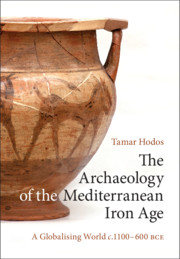Book contents
- The Archaeology of the Mediterranean Iron Age
- The Archaeology of the Mediterranean Iron Age
- Copyright page
- Dedication
- Contents
- Illustrations
- Preface
- Acknowledgements
- One Interpreting the Mediterranean
- Two Chronologies and Histories
- Three The Movement of People
- Four Contacts and Exchanges
- Five Urbanisation
- Six Written Words
- Seven Conclusions
- Notes
- References
- Index
Three - The Movement of People
Published online by Cambridge University Press: 12 September 2020
- The Archaeology of the Mediterranean Iron Age
- The Archaeology of the Mediterranean Iron Age
- Copyright page
- Dedication
- Contents
- Illustrations
- Preface
- Acknowledgements
- One Interpreting the Mediterranean
- Two Chronologies and Histories
- Three The Movement of People
- Four Contacts and Exchanges
- Five Urbanisation
- Six Written Words
- Seven Conclusions
- Notes
- References
- Index
Summary
The trait that most characterises the Mediterranean Iron Age is the movement of groups and individuals on an unprecedented scale, particularly the Phoenicians and the Greeks. Their settlement around the Mediterranean is the focus of this chapter. Understanding the motivation behind any such mobility enables us to then characterise the nature of that movement. Scholars have therefore often sought overarching reasons, such as economic pressure on the Phoenicians to pay tribute to the Neo-Assyrians, or overpopulation in the case of the Greeks. Climatic developments are also cited as a push factor, building on recent evidence of more arid, cooler and unstable conditions around the Aegean and eastern Mediterranean between the thirteenth and tenth centuries, and efforts have been made to link such changes to very particular events. None of these can be applied broadly, however. As we shall see below, new data for Phoenician movement in the Mediterranean no longer supports the tribute payment theory, while for the Greeks, the only regions that seem to demonstrate population increase in the early first millennium BCE are those that do not appear to have established settlements elsewhere in the Mediterranean at this time. With regard to the environmental evidence for this era more generally, since most climate data are on multi-decadal to century-plus scales, it is extremely difficult to tie these results to a particular historical process. Furthermore, given the geographic microregionality of the Mediterranean zone itself, neighbouring regions may not have necessarily experienced the same environmental changes concurrently, if at all, although change in one area may well have impacted on another region because of response strategies in the climate-affected area. In short, no single explanation can account sufficiently for the variety of developments we see in the centuries around the turn of the first millennium BCE. The scenario was much more complex and multifaceted. Motivations behind mobility, therefore, must be assessed on a case-by-case basis.
- Type
- Chapter
- Information
- The Archaeology of the Mediterranean Iron AgeA Globalising World c.1100–600 BCE, pp. 66 - 94Publisher: Cambridge University PressPrint publication year: 2020



